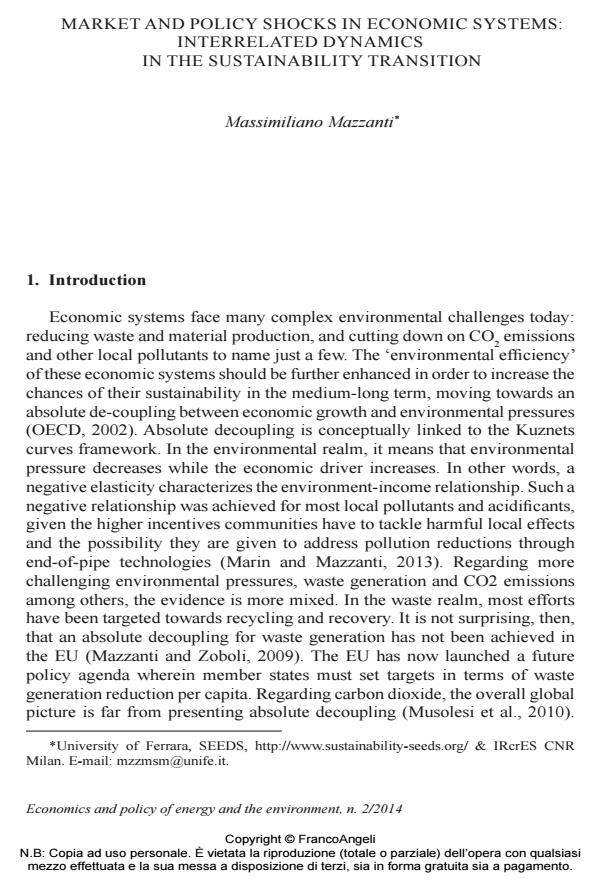Market and policy shocks in economic systems: interrelated dynamics in the sustainability transition
Titolo Rivista ECONOMICS AND POLICY OF ENERGY AND THE ENVIRONMENT
Autori/Curatori Massimiliano Mazzanti
Anno di pubblicazione 2015 Fascicolo 2014/2 Lingua Inglese
Numero pagine 12 P. 153-164 Dimensione file 243 KB
DOI 10.3280/EFE2014-002008
Il DOI è il codice a barre della proprietà intellettuale: per saperne di più
clicca qui
Qui sotto puoi vedere in anteprima la prima pagina di questo articolo.
Se questo articolo ti interessa, lo puoi acquistare (e scaricare in formato pdf) seguendo le facili indicazioni per acquistare il download credit. Acquista Download Credits per scaricare questo Articolo in formato PDF

FrancoAngeli è membro della Publishers International Linking Association, Inc (PILA)associazione indipendente e non profit per facilitare (attraverso i servizi tecnologici implementati da CrossRef.org) l’accesso degli studiosi ai contenuti digitali nelle pubblicazioni professionali e scientifiche
This note addresses the issue of market and policy shocks in the transition to sustainability. Market Shocks may be driven by price volatility; policy shocks are likely to occur either given contingent conditions of policy feasibility - a concept that shifts over time - or in reaction to extreme climatic events. The paper questions the role of ‘events’ as drivers of change, with a focus on innovation responses. In doing so, it broadens the perspective on environmental policy’s role and effects. Environmental policy is connected to institutional and market dynamics. It is not limited to the Pigovian rationale - the mere minimization of current costs - but rather tied to a ‘standard and cost approach’ which attempts to incorporate efficiency concepts in a dynamic scenario, where learning and adaptation through technological and behavioral changes are crucial.
Keywords:Shocks, environmental performances, dynamics, policy
Jel codes:O1, Q5
- Borghesi S., Costantini V., Crespi F., Mazzanti M. (2013). Environmental Innovation and socio economic dynamics in institutional and policy contexts. Journal of Evolutionary Economics, i-first.
- Borghesi S. (2011). The European emission trading scheme and renewable energy policies: credible targets for incredible results? International Journal of Sustainable Economy, 3(3), 312-327.
- Chichilnisky G. (2013). Modelling growth and socio ecological transitions – chances and challenges, Public WWWfor Europe project lecture, Wien, March 12th, 2013.
- Chichilnisky G., Eisenberger P. (2009). Energy security, economic development and global warming: addressing short and long term challenges. International Journal of Green Economics, 3(3), 414-446, January.
- Costantini V., Mazzanti M. (2012). On the green side of trade competitiveness? Research Policy, February, 41, 2.
- Costantini V., Mazzanti M. (2013). The Dynamics of Economic and Environmental Systems. Innovation, Policy and Competitiveness. Springer.
- Edenhofer O., Stern N. (2009). Towards a global green recovery, PDI/LSE Report .
- EEA (2013a). Achieving energy efficiency through behaviour change: what does it take?. EEA, Copenhagen.
- EEA (2013b). Towards a green economy in the EU, Copenhagen, European Environment Agency.
- Lehtonen M. (2004). The environmental–social interface of sustainable development: capabilities, social capital, institutions Ecological Economics, 49, 2, 1, 199-214.
- Marin G., Mazzanti M. (2013). The evolution of environmental and labour productivity dynamics. Journal of Evolutionary Economics, i-first.
- Mazzanti M., Musolesi M. (2013). Breaking environmental Kuznets curves, Working paper INRA Grenoble.
- Mazzanti M., Musolesi A. (2014). Non linearity, heterogeneity and unobserved effects in the CO2 income relation for advanced countries. Studies in non linear Dynamics and Econometrics, forth (available as FEEM working paper 91/2013).
- Mazzanti M., Zoboli R. (2009). Environmental efficiency and labour productivity: trade-off or joint dynamics?, Ecological Economics, 68, 4, 1182-94.
- Mazzucato M. (2012). The Entrepreneurial state Debunking Public vs. Private Sector Myths, Anthem Other Canon Economics.
- OECD (2002). Indicators to measure decoupling of environmental pressure from economic growth. OECD, Paris.
- Pearce (2004). The social costs of carbon and its policy implications. Oxford review of economic Policy, 19, 3.
- Putnam R. (2001). Bowling alone. Simon & Schuster. Rotmans J. (2013). Modelling growth and socio ecological transitions – chances and challenges, Public WWWfor Europe project lecture, Wien, March 12th, 2013.
- Silverberg G., Verspagen B. (2007). The size distribution of innovations. The Cambridge Journal of Economics, 27, 671-693.
- Van den Bergh J. (2011). Environment versus growth - A criticism of “degrowth” and a plea for “a-growth”.
- Ecological Economics, 70, 5, 15 March, 881-890.
- Van den Bergh, Jeroen C. J. M. (2013). Policies to enhance economic feasibility of a sustainable energy transition. PNAS, 110, 2436-2437, DOI: 10.1073/pnas.1221894110
- Van den Bergh J. (2010). Externality or sustainability economics? Ecological Economics, 69, 11, 2047-2052.
- Vogt-Schilb A., Hallefatte S. (2013). Marginal Abatement Cost Curves and the Optimal Timing of Mitigation Measures, FEEM nota di lavoro 89, FEEM, Milan.
Massimiliano Mazzanti, Market and policy shocks in economic systems: interrelated dynamics in the sustainability transition in "ECONOMICS AND POLICY OF ENERGY AND THE ENVIRONMENT" 2/2014, pp 153-164, DOI: 10.3280/EFE2014-002008